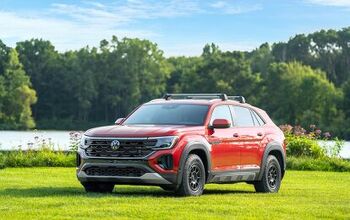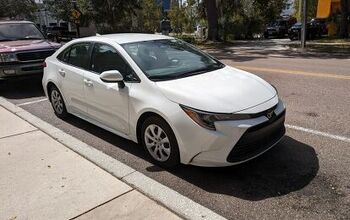Editorial: Volt Syndrome Strikes In China
A few weeks of vacation from the blogosphere’s non-stop news cycle can leave a blogger feeling a bit behind the times. Two weeks is an eternity in internet time, but stepping away from the barrage of news, spin, hype and hysteria is good for the sense of perspective. Especially if the down time is spent exploring countries on the local typical family vehicle, complete with two wheels, four speeds and about 100ccs of thundering power. Beyond the sheer novelty of seeing entire families commuting on a moped (“Daddy, Nguyen isn’t staying on his side of the pillion seat”), travel in the developing world shows how insulated America is from the transportation realities of the rest of the world. If the $1,000 entry to the world of moped ownership is a major (if attainable) hurdle for workaday Vietnamese, even sub-$10K vehicles face what a GM sales release might call “a challenging sales environment.” Try to explain the “green premium” for hybrids and plug-in vehicles to an auto-aspirational third-worlder, and watch as the idea of paying more for less room and power draws only puzzled bemusement. Hair shirts, it appears, are strictly a fad for the western and wealthy. Case in point: the world’s first plug-in hybrid, the Chinese BYD F3DM.
BYD’s Corolla-aping PHEV raised more than a few eyebrows (many skeptical) when specs and concepts first appeared. Warren Buffet’s hefty investment into the cell phone battery maker quieted the skeptics and gave green-hued futurists a license to thrill. A 60-mile plug-in range, a multiple-mode hybrid system and a price tag under $25K had American hypermilers factoring in local tax credits and greengasming at the fantasy of it all. But in the world’s new largest market for automobiles, even $20K is a huge amount of money. And it turns out that one society’s eco-fantasy is another society’s overpriced, overly-complex answer to a question nobody has asked.
Xinhua reports (yes, nearly a week ago) that BYD’s F3DM has utterly failed to attract Chinese consumers; the firm has sold only 80 models since it went on sale in December. Apparently 20 of those were bought by the city of Shenzhen (think China’s Detroit) with the rest going to the local branch of China Construction Branch. In fact, BYD never even attempted to target private consumers with the model, despite the fact that an F3DM costs 30-40 percent less than a Toyota Prius (which only sold about 3,500 units in China between 2006 and 2008). Even the government isn’t rushing to put its citizens in the alleged volks-hybrid, offering a $7K hybrid subsidy to fleet buyers only.
Even with government help bringing the F3DM’s price under $20K, fleet sales aren’t as strong as BYD had hoped. Shenzen’s plan to buy more for the city’s taxi fleet is on hold as even BYD officials admit that the price needs to come down. BYD’s CEO Wang Chuanfu says that increasing production volume could help bring the F3DM’s price to a more-realistic $15K, but without institutions stepping up to prime the sales pump, the promise of a sub-$10K PHEV (after government subsidies)—and mass market sales—remain out of reach.
And even though the F3DM isn’t dependent on a charging-station infrastructure, price isn’t the only concern keeping buyers away. BYD faces an image challenge having never made anything more car-like than a laptop battery just a few years ago, and even its much-vaunted battery technology seems to struggle to meet on-paper performance numbers. According to Xinhua (hardly bomb-throwers when it comes to Chinese businesses), the 60-mile electric range is only attainable driving at a steady 30 mph. And recharging from a home wall socket takes nine hours.
But these tradeoffs and the correlating plug-in efficiency rewards only have meaning in the context of price, and here the lesson for Chevy’s Volt are plain to see. GM’s $40K profitless wonder defies fiscal logic on a comparable scale, offering only the most image-conscious greenies a value proposition worth even including. Like the F3DM, the Volt’s target audience (if not consumer) is the government, and the same increased volume-decreased price mirage lingers on the horizon. But unlike China (BYD expects its sales to double for the second year in a row, hitting 400,000 units), America’s demand for automobiles is in double-digit decline. And that includes demand for the much cheaper hybrids that are already available in the marketplace.
But we don’t have theorize about private PHEV sales levels for much longer. Shenzhen rolled out hybrid subsidies for private consumers this month which would cut the price of an F3DM in half, to about $10K. This coincides with a BYD plan to launch “a mass marketing excercise to promote the car to private buyers.” But if the car-crazed, yet pragmatic Chinese do start buying the F3DM, it will be at half the original MSRP, a feat that GM can’t hope to pull off with its Volt. Unless they just slap in powertrains from BYD, which is hedging its consumer-market gamble by offering to license technology to Western firms. In any case, BYD’s consumer sales push will give us some idea of private PHEV demand (and its required stimulus) by the time the Volt launches. Sales trends are easier to follow when they start at 80 units per quarter.
More by Edward Niedermeyer
Latest Car Reviews
Read moreLatest Product Reviews
Read moreRecent Comments
- Brian Uchida Laguna Seca, corkscrew, (drying track off in rental car prior to Superbike test session), at speed - turn 9 big Willow Springs racing a motorcycle,- at greater speed (but riding shotgun) - The Carrousel at Sears Point in a 1981 PA9 Osella 2 litre FIA racer with Eddie Lawson at the wheel! (apologies for not being brief!)
- Mister It wasn't helped any by the horrible fuel economy for what it was... something like 22mpg city, iirc.
- Lorenzo I shop for all-season tires that have good wet and dry pavement grip and use them year-round. Nothing works on black ice, and I stopped driving in snow long ago - I'll wait until the streets and highways are plowed, when all-seasons are good enough. After all, I don't live in Canada or deep in the snow zone.
- FormerFF I’m in Atlanta. The summers go on in April and come off in October. I have a Cayman that stays on summer tires year round and gets driven on winter days when the temperature gets above 45 F and it’s dry, which is usually at least once a week.
- Kwik_Shift_Pro4X I've never driven anything that would justify having summer tires.

































Comments
Join the conversation
@Aqua225 "If oil was to be suddenly shut off to this nation, we’d quickly crash into the abyss of bygone empires". Shhhhhhhhhh....don't tell anyone.... .....and for an excellent interview with Dr. Colin Campbell, the most prominent current advocate of the Peak Oil scenario... http://europe.theoildrum.com/node/5315
Saw a lot of F3s in the Dominican recently, I was surprised they were so common. A lot of F3 taxis so close to our shores, in a poorer country they seem to make good sense right now. Also saw Chinese bikes and pickups.